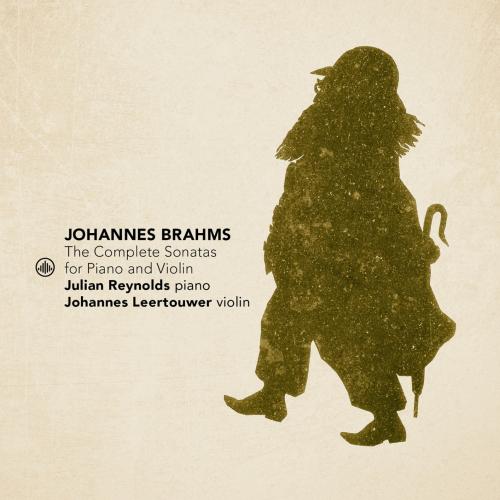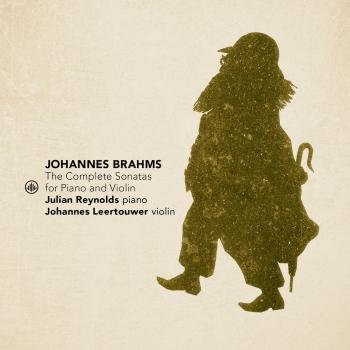
Brahms: The Complete Sonatas for Piano and Violin Johannes Leertouwer & Julian Reynolds
Album info
Album-Release:
2023
HRA-Release:
04.08.2023
Label: Challenge Classics
Genre: Classical
Subgenre: Instrumental
Artist: Johannes Leertouwer & Julian Reynolds
Composer: Johannes Brahms (1833-1897)
Album including Album cover Booklet (PDF)
- Johannes Brahms (1833 - 1897): Violin Sonata No. 1, Op. 78 in G Major:
- 1 Brahms: Violin Sonata No. 1, Op. 78 in G Major: I. Allegro ma non troppo 10:56
- 2 Brahms: Violin Sonata No. 1, Op. 78 in G Major: II. Adagio 07:10
- 3 Brahms: Violin Sonata No. 1, Op. 78 in G Major: III. Allegro molto moderato 08:34
- Violin Sonata No. 2, Op. 100 in A Major:
- 4 Brahms: Violin Sonata No. 2, Op. 100 in A Major: I. Allegro amabile 08:59
- 5 Brahms: Violin Sonata No. 2, Op. 100 in A Major: II. Andante tranquillo - Vivace- Andante- Vivace di più- Andante - Vivace 06:53
- 6 Brahms: Violin Sonata No. 2, Op. 100 in A Major: III. Allegretto grazioso (quasi andante) 05:53
- Violin Sonata No. 3, Op. 108 in D Minor:
- 7 Brahms: Violin Sonata No. 3, Op. 108 in D Minor: I. Allegro 08:48
- 8 Brahms: Violin Sonata No. 3, Op. 108 in D Minor: II. Adagio 04:09
- 9 Brahms: Violin Sonata No. 3, Op. 108 in D Minor: III. Un poco presto e con sentimento 03:09
- 10 Brahms: Violin Sonata No. 3, Op. 108 in D Minor: IV. Presto agitato 06:25
Info for Brahms: The Complete Sonatas for Piano and Violin
A brand new recordings of Brahms' Sonatas for Piano and Violin presented according to period performance practice.
"We made this recording in January 2023, one week before I defended my dissertation on historically informed performance practice of Brahms's orchestral music at Leiden University and received my doctorate. The research had offered me the opportunity to re-investigate my ideas about contemporary performance style, particularly of 18th- and 19th-century repertoire. Over the course of the 4-year project, I had rehearsed, performed, and recorded the Brahms symphonies and concertos as a conductor. After so much reading, writing, and conducting, I found that I longed for the experience of applying what I had discovered as a violinist to find how it had changed my approach to Brahms's chamber music. I called Julian Reynolds and asked if he would be willing to experiment with my findings. We had studied the Brahms violin sonatas together with Josef Suk in Vienna and Prague many years ago. We found a beautiful Bluthner grand piano of 1857 in the atelier of Andriessen pianos in Haarlem.
Our recording represents our desire to find the freedom to apply the 19th-century expressive tools of flexibility of rhythm and tempo, of expressive legato, portamento and vibrato that have been largely forgotten or perhaps discarded over the course of last century. These tools cannot simply be dusted off and re-implemented. As I argued in my dissertation, working with them requires re-inventing them. Portamento for example was a hotly debated subject throughout the 19th century. There is no single model or example of how to apply it today. The same can be said about vibrato. What we can say with certainty is that in the violin methods of Louis Spohr and later Joseph Joachim and Andreas Moser, portamento was named as the first and most important means of expression for string players, and vibrato was described as an ornament. When it comes to flexibility of tempo, we can be sure that the 19th-century concept of tempo was more flexible, and that modifications of tempo were much more frequent than in more modern times. We know that Brahms had a particularly free and flexible way of performing his own music. Brahms himself famously refused to give metronome markings, writing that he could not find a meaningful relationship between his flesh and blood and such a mechanical instrument, a feeling perhaps inherited from Beethoven. He also wrote that any "sane musician" would take a different tempo every week." (Johannes Leertouwer)
Johannes Leertouwer, violin
Julian Reynolds, fortepiano
Johannes Leertouwer
is chief conductor and artistic director of the recently formed Nieuwe Philharmonie Utrecht.
In September of 2009, he conducted this orchestra in an exciting and much praised debut which featured a program of Stravinsky and Ravel and he will continue to lead the NPU in a series of concerts and special projects in the coming years. The orchestra performs on period instruments as well as repertoire of the nineteenth- and early twentieth century. It also features an extensive educational program, and therefore clearly carries the signature of its chief conductor.
Johannes Leertouwer studied conducting with David Porcelijn and the legendary Finnish professor Jorma Panula, He has worked as guest conductor with various orchestras, such as the Noord Nederlands Orkest, choir and orchestra of the Netherlands Bach Society. He has also worked with orchestras in Belgium, France, Japan and Mexico. From 1989 to 2006 he was artistic director and conductor of the Netherlands Youth String Orchestra, and also conducted various projects at European conservatories in Paris, Antwerp, Leipzig and Amsterdam.
After studying violin with Bouw Lemkes in Amsterdam and Josef Suk in Vienna and Prague, Johannes Leertouwer decided to specialize in historical performance practice. He worked as concertmaster and soloist with a number of international period instrument ensembles and orchestras, such as Anima Eterna, and the orchestra and choir of the Nederlandse Bach Vereniging.
Together with his duo partners Menno van Delft (harpsichord) and Julian Reynolds (fortepiano) he has made a series of CD recordings on the Globe label which feature works by Bach, Mozart, Beethoven, Schubert and Schumann. With the Schönbrunn Ensemble, of which he has been a member since its founding in 1987, he performs both in the Netherlands and abroad. He has also made a series of CD’s with this ensemble, the most recent of which contains works of Graf, Reicha and Ries. In 2006, the Mozart year, Johannes Leertouwer was the soloist and conductor in a highly acclaimed CD-recording of the complete works for violin and orchestra by Mozart (Challenge).
Since 1989 he has been a professor of violin at the Conservatory of Amsterdam. He gives masterclasses and guest teaches in many countries both within and outside of Europe. As a conductor he is able to draw not only on his years of experience with the ensembles and orchestras that are leading the way in historical performance practice, but also on his experience in Romantic and twentieth-century orchestral practice. Already during his violin studies he worked with world famous conductors such as Haitink, Abbado, Bernstein and Harnoncourt.
Johannes Leertouwer is a conductor with a broad repertoire and an exceptionally acute consciousness of style. From his specialization, the Viennese Classics, he has built up his repertoire without limiting himself to any particular style period. Among the works he has conducted are Sibelius’ Symphony No.5, Berlioz’s Symphonie Fantastique and Bach’s St. Matthew Passion; he has also conducted world premieres of works by Patricio Wang, Maurice Horsthuis, Frank Agsteribbe and others.
Booklet for Brahms: The Complete Sonatas for Piano and Violin










